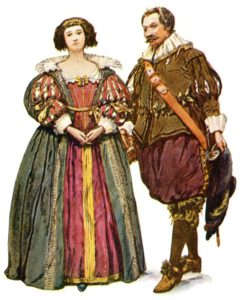
“Most Dutch came to America simply because they calculated that the future promised more prosperity for them and their children in America than in Holland.”
By MYRA VANDERPOOL GORMLEY, CG
Copyright © 1987, 2006—All rights reserved.
Do not post or publish without written permission.
There was no mass migration from Holland in any century as there was from other European countries. Few Dutch emigrated because of religious beliefs or for libertarian political ideals. The Dutch had it pretty good at home compared to the rest of the world—especially in the 17th Century.
Most Dutch came to America simply because they calculated that the future promised more prosperity for them and their children in America than in Holland. The Dutch were ever “family, faith, and farming” advocates. And the Dutch—as opposed to the Puritans—enjoyed the materialistic and creature comforts in life that their hard-earned money bought.
Most of us learn in grade school that the Dutch settled New York, particularly Manhattan and Albany. However, at the time New Netherland fell to England in 1664, there were not only settlements at New Amsterdam and Fort Orange, but on Long Island and at various small settlements scattered up and down the Hudson and Delaware rivers.
The total white population of New Netherland is estimated to have been eight to ten thousand in 1664—about two-thirds of whom were Hollanders—or who would become known as Holland Dutch to their descendants centuries later.
However, your research on Dutch lines may take you back to Connecticut where Dutch settled in the 1620s at the mouth of the Connecticut River or to Fort Good Hope in 1633. In the 1630s the Dutch were also living on the Delaware River in what is now the state of Delaware.
South Carolina had Dutch settlers from New York and Holland by 1671. New Jersey—especially the northern area —received many Dutch settlers, mostly from New York from about 1710. And the famous Plymouth Colony of 1620 is Massachusetts is said to have had some Dutch Pilgrims as well as English ones.
The 1790 U.S. census shows about 100,000 Dutch-born or Dutch-ancestry families, and at that time 80,000 of them lived within a 50-mile radius of New York City. However, by 1970 the No. 1 Dutch settlement was located in the northern Midwest within a 50-mile semicircle around the shoreline of Lake Michigan from Muskegon to Green Bay, Mich.; the No. 2 area being New York and northern New Jersey. Additional Dutch settlements include northwest Iowa and adjacent counties in southwest Minnesota, southeastern South Dakota, and in southern and central parts of California.
Three distinct phases of immigration by the Dutch to America since the early 17th Century have occurred:
- Immigration occasioned by commercial expansion of the 17th Century.
- Free immigration of the 19th and 20th centuries.
- Planned immigration following World War II
The New Netherland settlement attracted fur-trading adventurers as well as religious refugees and poverty-stricken Belgian Walloons, French Huguenots, Italian Waldensians, and Dutch soldiers and Jewish settlers from an aborted Brazilian colony. Then came teenagers from Dutch poorhouses and orphan asylums, families of unemployed day laborers from Amsterdam, agriculture tenants from landed estates and a few potential visionaries.
The Dutch tended to have large families and as farmland became scarce the young families—especially the newlyweds—pushed northward into virgin land along the Hudson tributaries of the Harlem, East, Mohawk and Pocantico rivers. Others moved southward into New Jersey following the Hackensack, Passaic and Raritan rivers. Some families settled in the southeastern part of Pennsylvania. By the 1780s the Dutch families were living in central New York and on the Kentucky frontier. By the early 19th Century there were many Dutch in western New York farms and in the Great Lakes area. Dutch farmers became the vanguard of the northern Colonial frontier.
There was a great migration of Dutch in the mid-19th century when about 250,000 Dutch peasants and rural artisans came to America. This began in the 1830s, continued into the mid-1840s—triggered by the potato crop failure and a pietistic revolt against the Dutch Reform Church—when about 20,000 people emigrated en masse. Many of them settled in southwestern Michigan, central Iowa and in the Fox River Valley of Wisconsin.
Those who came after the Civil War tended to be individuals who were stimulated by letters from family and friends in America and most of them came from the Achterhoeck (Backcorner) along the German border and from the regions of sea-clay soil and along the North Sea.
In the 1880s there was an agricultural crisis in the northern Netherlands and about 75,000 people immigrated to America because of it, some of whom went first to Michigan, Iowa or New York and then to Washington state. From 1900 to 1914 another 75,000 Dutch emigrants made their way through Ellis Island to these shores.
Special collections pertaining to the Dutch can be found at Syracuse University, Los Angeles Public Library, Bentley Historical Library at University of Michigan, Dordt College in Sioux Center, Iowa, Northwestern University in Evanston, Ill., and at the Holland Society of New York.
On the Web . . .
- Holland Society: www.hollandsociety.org
- Dutch and Swedish Culture in Colonial America:www.cr.nps.gov/history/online_books/regional_review/vol6-1-2d.htm
- The United States of American and the Netherlands Introduction: odur.let.rug.nl/~usa/E/newnetherlands/nl00.htm
- The First Dutch Settlers: odur.let.rug.nl/~usa/E/newnetherlands/nl2.htm
- The Holland Ring: Oh, that Dutch feeling! www.thehollandring.com/holland.shtml
- Dutch Immigration: www.spartacus.schoolnet.co.uk/USAEholland.htm
